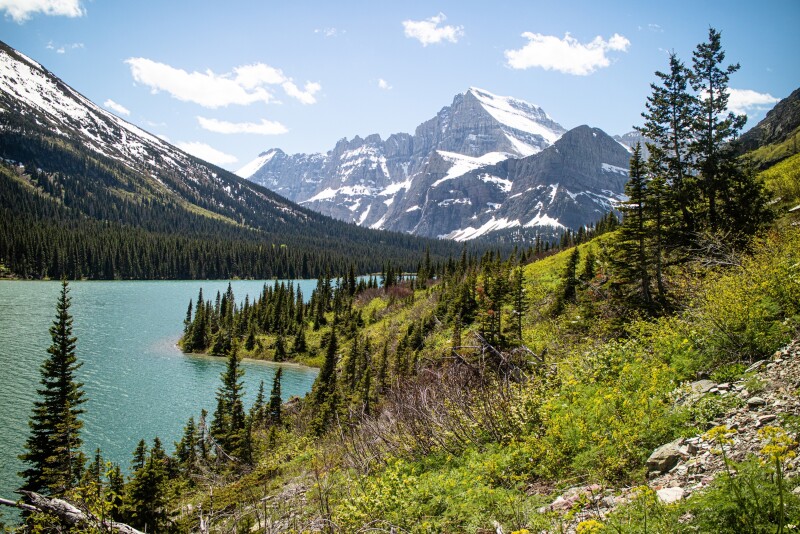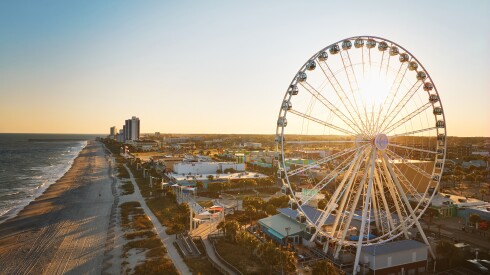Every summer, millions make the pilgrimage to some of America’s marquee national parks: Zion, Grand Canyon, Yellowstone, Yosemite, and Glacier. There’s no denying that Yellowstone’s Old Faithful is spectacular, but the crowds can often make these spaces feel congested during peak season.
A shortage of National Park staff in 2025 has led to reduced visitor hours and a reduction in trail maintenance—and has even impacted shuttle access. The United States has an abundance of beautiful, lesser-visited, and underrated national parks such as North Cascades National Park and Black Canyon of the Gunnison National Park. However, it’s still possible to make a crowd-free visit to the most popular national parks.
We tapped local guides, outfitters, hotel managers, bartenders, and longtime residents in popular parks to find some of the best ways to escape from the masses. Whether it’s choosing a low-profile hike, going through a less-trafficked entrance, or working with a professional to craft a personalized tour, here’s how to go off the beaten path at some of the busiest national parks in America.
Glacier National Park

Set on the spine of the Northern Rockies in Montana, Glacier National Park is a wonderland of jagged peaks, turquoise lakes, and more than 700 miles of hiking trails.
Photo by Wichakorn Kitrungrot/Shutterstock
To avoid the crowds at Glacier National Park, Carolyn Zimmerman, general manager of glamping brand Under Canvas’s Glacier outpost, encourages travelers to come in through the Camas Road Entrance (rather than the West Glacier or St. Mary Entrances), which she says offers a scenic and less-used route into the park.
Similarly, Mitchell Bump, owner of Kalispell Grand, a historic hotel in the gateway community of Kalispell, advises travelers to consider the Inner North Fork Road instead of Going-to-the-Sun Road for a slower-paced drive with gorgeous views.
Instead of famed destinations like Logan Pass and the Highline Trail, several alternatives offer a more relaxed experience. “For a shorter and flatter hike with breathtaking views, try the Grinnell Lake trail in the Many Glacier area—just note that due to construction, a shuttle ticket is required this year,” Zimmerman says. “For off-the-beaten-path hiking, check out the Whitefish Trails, including routes to Beaver Lake, Dollar Lake, and Woods Lake.”
If you’re after lakeside relaxation, Zimmerman suggests lesser-known places such as Snyder Lake and Lake Five. The Two Medicine and St. Mary regions are good choices for scenic boat tours (offered by companies like Glacier Park Boat Company).
On the boundary of the park, Bump says can’t-miss general stores include the Polebridge Mercantile, and Glacier Park Trading Company in East Glacier, while Colter Coffee Roasting, Ceres Bakery, Desoto Grill, and Bias Brewing are favorites for food and drink. Zimmerman says that her team also likes to frequent the various roadside cherry stands.
Grand Canyon National Park

Grand Canyon National Park had nearly 5 million visitors in 2024.
Photo by Andrew Tufenkian/Shutterstock
“The Grand Canyon rewards early risers,” says Michael Reardon, general manager of Trailborn Grand Canyon, a new outdoor-focused hotel just outside the park. “Hit popular spots at sunrise—the light is stunning, and the crowds are minimal.” He added that a less congested route through the park involves starting at Desert View Watchtower on the South Rim for panoramic views and stopping at the various overlooks as you work your way west.
If you’re up for a hike, Reardon recommends the South Kaibab Trail, which he says is quiet and a fine introduction to the Canyon’s interior. Joseph Hamblin, an interpretive training specialist in the area at park and resort management company Xanterra Travel Collection, says the Rim Trail from the Yavapai Museum of Geology to Grand Canyon Village is great for kids: “The paved 1.5-mile route has labeled mineral samples from the canyon, as well as markers that help indicate the vast scale of geologic time.”
Experiences beyond the rim overlooks can also get travelers away from the crowds. “We love recommending the Grand Canyon Discovery Tour by Wildland Trekking for an immersive guided hike or a helicopter flight with Maverick for an aerial perspective,” Reardon says. “In the evenings, there’s Flagstaff Stargazing Adventures, who will introduce you to astronomy, astrophotography, and constellation mythology.”
While there are myriad things to do outside the park, Reardon recommends Bearizona. It is home to animals that can’t be released into the wild and gives guests a chance to learn about wildlife conservation firsthand. For shopping, he says Civitan on 66 has a treasure-hunt vibe (proceeds also support the local special needs community).
Yellowstone National Park

To escape the crowds at Yellowstone, hit the trails.
Photo by Breann1/Shutterstock
Park officials estimate that only about 2 percent of all visitors hike more than a half-mile from their cars in Yellowstone National Park, which means solitude is only a short walk away. In the geyser-heavy Midway and Lower Geyser Basins, the Fairy Falls Trail offers a crowd-free backdoor view of Grand Prismatic Spring from above—especially if you go early. Avoid the heavily trafficked West Entrance if you can, and consider entering through the Northeast Gate near Cooke City or the South Entrance via Grand Teton; both offer a more relaxed arrival.
Consider visiting areas such as the Specimen Ridge Trail, a prime wildlife viewing spot often overlooked by visitors focused on geysers. For the well-known spots, Yellowstone Peaks Boutique Hotel owner Mara Repetto says it’s better to visit after 5 p.m.—that’s when the tour buses and day-trippers are less likely to be out.
Todd Walton, director of marketing at Yellowstone National Park Lodges, says the gateway community Gardiner, Montana, is best for groceries and essentials, while Cody, Wyoming, has more specialty shops such as Joyvagen Cycles and art studio By Western Hands. In Island Park, Idaho, Repetto says TroutHunter Bar & Grill is popular with guides and anglers due to the bison burgers and riverfront patio, while Cafe Sabor is a local go-to for tacos and margaritas.
Within the park, Walton recommends Roosevelt Lodge’s bar, the Roosevelt Saloon, which serves whiskey-based cocktails to enjoy on the wraparound porch. Mammoth Hotel’s Dining Room serves western-inspired fare, like Idaho red trout and locally sourced hanger steak.
Yosemite National Park

You can still visit Yosemite’s beloved spots—just be aware of timing.
Courtesy of Josh Carter/Unsplash
The most crowded places at the park include Yosemite Valley, Glacier Point, and Mariposa Grove. Heather Sullivan, cofounder of Balanced Rock Foundation, a wellness organization that offers nature retreats and guided adventures parkwide, says those spots are certainly worth a stop. She recommends arriving early in the morning or later in the afternoon (which also means you don’t need a reservation to enter the park).
“In general, an alpine start [waking before sunrise] will have you beating a majority of the crowds on any of the popular trails, like Yosemite Falls, the Mist Trail, and the Four-Mile Trail, and in summer months is a good way to beat the heat,” Sullivan says.
Another way to manage the high temperatures of peak season, says David Bailey, owner of local hard cider tasting room and orchard Sierra Cider, is to cool off in a swimming hole on the Merced River: “There are a lot of great slow-running, shallow spots that get warmed up by the sun, perfect for a refreshing plunge and a relaxing day.” Tenaya at Yosemite resort general manager Brett Archer says one of his favorite Merced River spots is Superintendent’s Beach, which is right across from the Yosemite Chapel at Superintendent’s Bridge.
Aida Mollenkamp, founder of boutique travel company Salt & Wind Travel, recommends taking Tioga Pass to Eastern Yosemite, saying, “This side of the park is a world away from the crowds on the valley floor. Highlights include natural water slides, alpine lakes, Tuolumne Meadows, part of the Pacific Crest Trail, world-class climbing at Dozier Dome, and challenging hikes like Clouds Rest.”
To enhance your experience, Sullivan recommends bringing a bike or renting one in Curry Village, which will save you the hassle of Yosemite’s notorious summer traffic and trying to find parking. She also suggests hiring a local tour operator who specializes in your favorite outdoor activity for lesser-known experiences. Some small-group or private companies include Yosemite E-Biking, Nesporado Fly Fishing, and Zephyr Whitewater Expeditions for river rafting.
In gateway community Mariposa, Sullivan likes strolling between the historic downtown shops, visiting the Grove House for live music, and dining at Happy Goat, a farm-to-table restaurant. And though ramen might not be the first thing you think of in terms of Sierra Nevada cuisine, Bailey recommends the Little Shop of Ramen, also in Mariposa, adding, “The best part is that it shares restaurant space with the Local Grape, a wine bar specializing in local wines made from grapes grown in the Sierra Foothills viticultural region.” Alternatively, in Lee Vining, Mollenkamp likes Mono Market for trail snacks and Whoa Nellie Deli for gourmet sandwiches.
Zion National Park
As with most national parks, if you want to sidestep the masses, you’ll want to go early. That’s especially true at Zion, where from mid-May through the end of October when Zion Canyon Scenic Drive, the road connecting the most famous landmarks, such as Angels Landing and Weeping Rock, is closed to personal vehicles—the only way to access it is by the free shuttle service, and lines can get long.
Walker Belliston, general manager of glamping brand AutoCamp’s Zion location, recommends “getting to the park no later than 8 a.m. to secure a quick shuttle ride and enter some of the great hikes without a large group behind you.”
If an early start isn’t realistic, Robert Fegen, general manager of Under Canvas Zion, suggests this itinerary: “Spend the morning exploring Kolob Terrace, then enjoy lunch in [gateway community] Springdale, and head into Zion Canyon in the afternoon, when crowds begin to thin. Even a 4 p.m. visit works well.”
Working with local guides can also alleviate planning woes. Belliston says he typically suggests Summit Rides, a company that will deliver e-bikes to whatever location you choose and pick them up wherever you decide to finish your ride. He also favors Rock Odyssey, which offers canyoneering experiences in less trafficked areas, and Zion Adventures, which runs a range of via ferrata, hiking, and climbing tours.
You might also consider nearby state parks and conservation areas that offer similar scenery. Fegen suggests Snow Canyon State Park for dramatic landscapes shaped by ancient volcanic activity, Red Cliffs National Conservation Area for red rock canyons, and San Hollow State Park for water-based recreation.
In the gateway towns surrounding Zion National Park—most notably Springdale—you’ll find a range of gear shops, art galleries, and boutiques selling everything from handcrafted pottery inspired by the canyon’s colors to performance sandals. Springdale is also where the bulk of the eateries are.
On Thursday through Saturday (the only days it’s open), Belliston recommends the Pizza Wagon. “It’s a small business run by a father and his kids, though you will want to call and place an order ahead of time,” he says, adding that he also suggests “Desert Smoothie, which is a one-man truck with the best smoothies around.”











